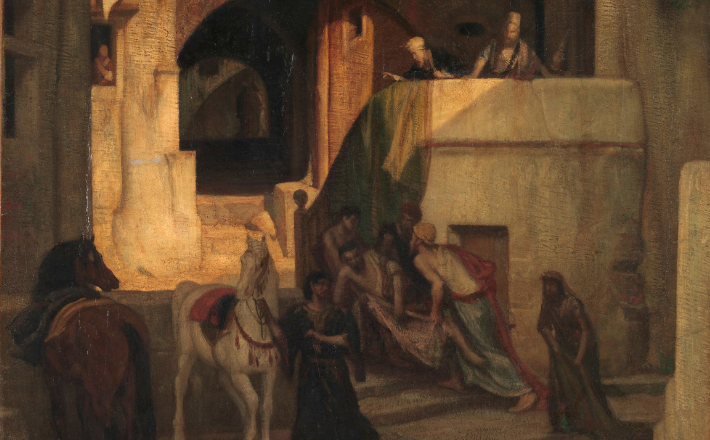Commentary on Luke 10:25-37
The Parable of the Good Samaritan is perhaps one of the most popular parables in the New Testament. This parable has single-handedly reshaped the reputation of the Samaritans, now associated with care and compassion for strangers rather than with the longstanding civil and religious disputes they had with their Jewish neighbors. But in many ways, its familiarity can make it more challenging for the exegete and preacher.
Parables are meant to provoke, to challenge the listener’s assumptions through vivid and often unexpected storytelling. But what happens when a story is so familiar that its strangeness is lost? When, in the retelling over centuries, the sharpness of the point is smoothed out? The goal of the preacher for a text like this one is to recapture some of that sharpness so that it might be able to challenge us to hear a new truth about the Kingdom of God.
A subverted question
While often we are tempted to lift this parable out of its Lukan context, focusing only on the details of the story Jesus tells, the setup for why Jesus tells this story is essential for understanding it. Luke tells us that Jesus was approached by a lawyer, who sought to test him, asking Jesus: “What must I do to inherit eternal life?” (verse 25). Jesus responds not by answering the question, but by asking the lawyer his thoughts on the question. The lawyer responds by quoting the Shema from Deuteronomy 6, “You shall love the Lord your God with all your heart and with all your soul and with all your strength and with all your mind” and includes Leviticus 19:18, “and [you should love] your neighbor as yourself” (Luke 10:27). Jesus affirms the lawyer’s correct answer, saying if he does these things, he will live.
But the lawyer is not satisfied. He goes in for one last question: “And who is my neighbor?” (verse 29).
It is in response to this question that Jesus tells the story of the Good Samaritan.
And because Jesus loves a good reversal of expectations, we first meet the priest and the Levite, who the audience would assume would help the man in need, only to watch them pass by on the other side of the road.
Then we are introduced to the Samaritan, an opponent of the Jewish people. The Samaritans were despised by their Jewish counterparts, being viewed as having both questionable lineage and questionable theology. Yet it is this person who goes above and beyond in his care of the injured man. He not only cares for the wounds of the man, but he also carries him to help and then pays for his continued care at the inn.
Having told the story, Jesus turns back to the lawyer: “Which of these three, do you think, was a neighbor to the man who fell into the hands of the robbers?” (verse 36).
The lawyer answers, albeit indirectly: “The one who showed him mercy” (verse 37). He cannot bring himself to say “The Samaritan.”
And in this way, Jesus has flipped the question upside down. The lawyer was asking for boundaries over who should be considered a neighbor. If neighbors must be loved as oneself, surely there must be limits. Jesus refuses to set any and instead doubles down. Instead of describing who is a neighbor, he discusses how to be a neighbor. He switches the conversation from neighbor as an object you decide to love to neighbor as the subject—how you embody being a neighbor.
Some interpreters have felt that in doing this, Jesus does not actually answer the man’s question, but I would argue that he intentionally subverts the question. In his answer, he tells the lawyer that his question was the wrong one. The question should not have been “Who is my neighbor?” The question should have been “How do I love my neighbor?”
As Franz Leenhardt argued: “One cannot define one’s neighbor; one can only be a neighbor.”1
And in his answer, Jesus teaches that one is a neighbor by going above and beyond in caring for those in need. The act of neighboring, like love, does not have a limit.
No boundaries in the Kingdom
Yet Jesus is not merely redefining what it means to be a neighbor; he is also deliberately choosing an enemy to be neighbor to make his point even sharper, adding another layer to this story. By selecting a nearby enemy of his audience, someone who is clearly part of an opposing “team,” he is pushing them beyond the fact that everyone is their neighbor. He is pushing them to see that, in fact, their enemy is also and especially their neighbor.
In this way, Jesus makes it clear that loving our enemies is not optional. Rather, it is essential to discipleship. Luke has already introduced this theme earlier in the Gospel, when, in the Sermon on the Plain, Jesus proclaims: “But I say to you who are listening: Love your enemies; do good to those who hate you; bless those who curse you; pray for those who mistreat you” (Luke 6:27–28). Now, in this parable, Jesus fleshes out that teaching. The Samaritan does not simply tolerate his Jewish neighbor; he loves him actively and abundantly, despite their hostility.
But Jesus pushes even further. This parable dismantles the very notion of boundaries, exposing the false divisions we draw between “us” and “them.” The Samaritan and the Jew were divided by history, culture, and theology, yet Jesus declares that their obligation to love supersedes all of it. In doing so, this story confronts the sin of racism for what it is: an attempt to carve out exceptions to God’s command to love, to create boundaries where none should be. The Kingdom of God allows no such divisions, and neither do the scriptures, which call us to love our neighbor as ourselves. And so, like the lawyer, we are left not with the question “Who is my neighbor?” but with the much harder one: “Will I choose to be a neighbor?”
Notes
- Franz Leenhardt, as quoted in Klyne R. Snodgrass, Stories with Intent: A Comprehensive Guide to the Parables of Jesus (Grand Rapids, MI: Eerdmans, 2008), 357.


July 13, 2025